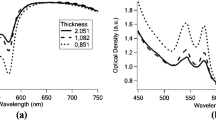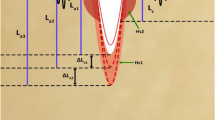Abstract
Cartilage undergoes characteristic mechanical stress relaxation following laser irradiation below the ablation threshold. Porcine auricular cartilage (1–2 mm thickness) was irradiated with a Nd:YAG laser (λ=1.32 μm) at two power levels (W/cm2). Surface temperature (S c (t) (°C)) (monitored using a single element HgCdTe infrared detector, 10-14 μm spectral range), and integrated back scattered light intensityI(t) were measured during laser irradiation. A HeNe laser beam (λ=632.8 nm) was incident on the back surface of the cartilage specimen and fractional integrated backscattered light intensity was measured using an integrating sphere anda silicon photodiode. Laser irradiation (5.83 W/cm2, 50 Hz pulse repetition rate (PRR)) continued until surface temperature reached approximately 70°C, during which cartilage mechanical stress relaxation was observed. Integrated back scattered light intensity reached a plateau at about 70°C). At higher laser power (39.45 W/cm2, 50 Hz PRR), a feedback-controlled cryogen spray was used to maintain surface temperature below 50°C. A similar plateau response was noted in integrated backscattered light intensity. This signal may be used to optimise the process of stress relaxation in laser cartilage reshaping. Several clinical applications involving reconstructive surgery are proposed.
Similar content being viewed by others
REFERENCES
Donnan FG. The theory of membrane equilibria. Chem Rev 1924; 1:73–90
Lai W, Hou J, Mow V. A triphasic theory for the swelling of hydrated charged soft biological tissues. In: Mow V, Ratcliffe A, Woo S-Y (eds) Biomechanics of Diarthroidal Joints. New York: Springer-Verlag, 1990:283–312
Lai W, Hou J, Mow V. A triphasic theory for the swelling and deformation behaviors of articular cartilage. J Biomech Engng 1991; 113:245–58
Fry H. Interlocked stresses in human nasal septal cartilage. Br J Plast Surg 1966; 19:276–8
Fry H. Cartilage and cartilage grafts: the basic properties of the tissue and the components responsible for them. Plast Reconstr Surg 1967; 40:426–39
Fry H, Robertson W. Interlocked stresses in cartilage. Nature 1967; 251:53–4
Helidonis E, Sobol E, Kavvalos G et al. Laser shaping of composite cartilage grafts. Am J Otolaryngol 1993; 14:410–2
Helidonis ES, Sobol E, Velegrakis G, Bizakis J. Shaping of nasal septal cartilage with the carbon dioxide laser — a preliminary report of an experimental study. Lasers Med Sci 1994; 9:51–4
Sobol E, Bagratashvili VV, Omel'chenko A et al. Laser shaping of cartilage. Proceedings SPIE 1994; 2128:43–9
Sobol E. Phase Transformations and Ablation in Laser-treated Solids. New York: John Wiley, 1995
Sobol E, Bagratashvili VV, Sviridov A et al. Cartilage reshaping with holmium laser. Proceedings SPIE 1996; 2623:556–9
Sobol E, Bagratashvili VV, Sviridov A et al. Phenomenon of cartilage shaping using moderate heating and its application in otorhinolaryngology. Proceedings SPIE 1996; 2623:560–4
Sobol E, Sviridov A, Bagratashvili VV et al. Stress relaxation and cartilage shaping under laser radiation. Proceedings SPIE 1996; 2681:358–63
Wang Z, Pankratov MM, Perrault DF, Shapshay SM. Endoscopic laser-assisted reshaping of collapsed tracheal cartilage: a laboratory study. Ann Otol Rhinol Laryngol 1996; 105:176–81
Wang Z, Pankratov MM, Perrault DF, Shapshay SM. Laser-assisted cartilage reshaping: in vitro and in vivo animal studies. Proceedings SPIE 1995; 2395:296–302
Nelson JS, Milner TE, Anvari B et al. Dynamic epidermal cooling during pulsed laser treatment of port-wine stain. Arch Dermatol 1995; 131:695–700
Anvari B, Milner TE, Tanenbaum BS, Kimel S, Svaasand LO, Nelson JS. Selective cooling of biological tissues: application for thermally mediated therapeutic procedures. Phys Med Biol 1995; 40: 241–52
Anvari B, Tanenbaum BS, Milner TE et al. Spatially selective photocoagulation of biological tissues: feasibility study utilizing cryogen spray cooling. Appl Optics 1996; 35:3314–20
Pearce J, Thomsen S. Rate process analysis of thermal damage. In: Welch A, van Gemert MJC (eds) Opticalthermal Response of Laser-irradiated Tissue. New York: Plenum, 1995: 561–606
Author information
Authors and Affiliations
Rights and permissions
About this article
Cite this article
Wong, B.J.F., Milner, T.E., Anvari, B. et al. Measurement of radiometric surface temperature and integrated backscattered light intensity during feedback-controlled laser-assisted cartilage reshaping. Laser Med Sci 13, 66–72 (1998). https://doi.org/10.1007/BF00592961
Issue Date:
DOI: https://doi.org/10.1007/BF00592961




